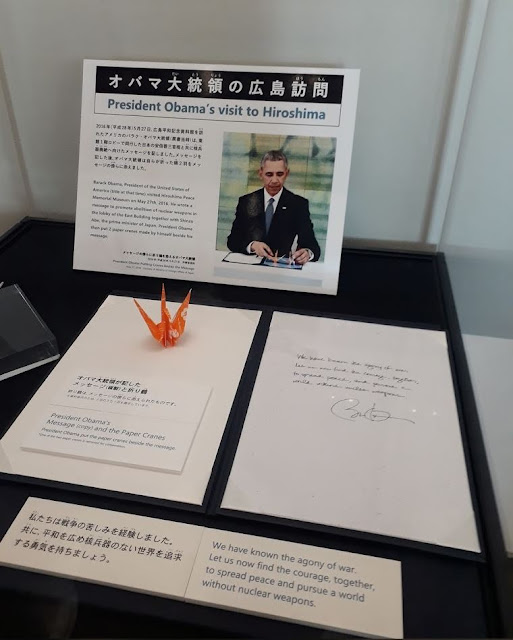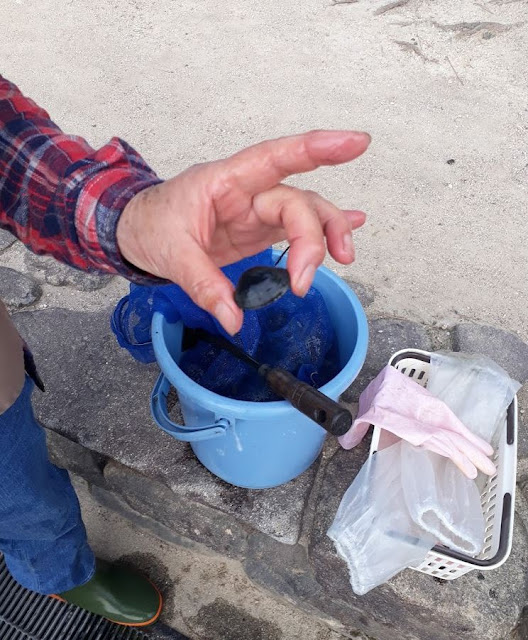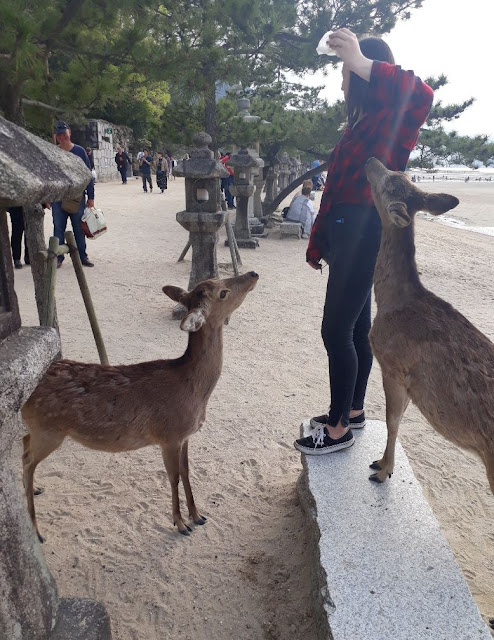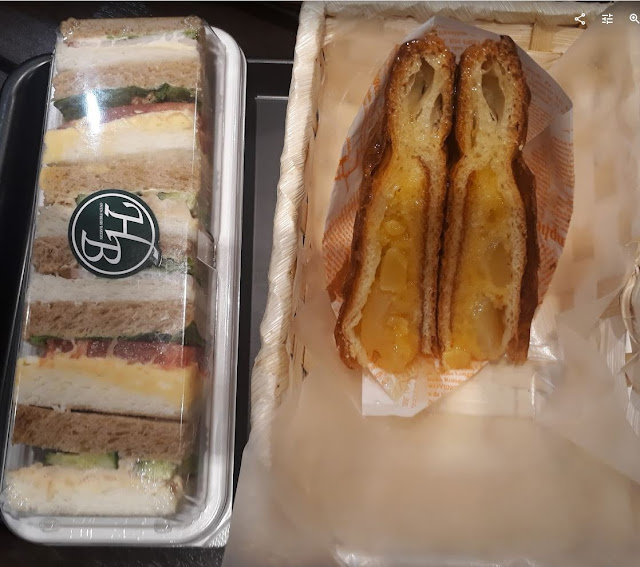16 tips for travelling to Hiroshima and Miyajima Island in one day
 |
| The A-Dome, Hiroshima |
We visited
Hiroshima and Miyajima Island in April 2019 as part of a day trip from Osaka.
On August 6,
1945 an Atomic bomb was exploded over the city of Hiroshima, followed by
another bomb over Nagasaki just three days later which effectively ended World
War 2 in the Pacific. These ‘new atomic bombs’ had devastating consequences for
the population of Hiroshima and Japan as a whole. Both cities were literally
flattened and nothing was left for the survivors.
We found Hiroshima
to be an extremely friendly city in Japan and visiting the war and peace
memorial sites was an emotional experience. We learned so much about what
happened on that fateful day and I really do recommend a visit. The whole
emphasis of Hiroshima is to promote peace – so that atomic (and nuclear bombs)
are never used ever again. So in a strange way, although the memorials are sad
– the city itself is very inspiring.
My husband
and I spoke a little about what happened at the end of World War 2 to our 11
year old daughter A.J before our trip. A.J found the memorials and museum
exhibits very interesting and the entire visit was extremely educational for
her. After visiting these memorials, she had even more questions for us (which
is a good thing).
After visiting the major sites of
Hiroshima, for a change of scenery, we did a quick trip to the World Heritage
Site of Miyajima island. Please note that the famous ‘floating’
Torii gate on Miyajima Island is going to be blocked off for repairs from June
2019 for approximately a year. You won’t be able to see the famous Torii gate
as it will be covered in scaffolding. However, there are many other nice things
to do on this island and it was definitely worth the trip (although next time
we must stay longer).
Please note that whilst we did both Hiroshima and Miyajima Island in one long day trip from Osaka, there are heaps to do in both places and I highly recommend an overnight stay or 2 separate days. You will miss a lot just doing one day and will need to prioritise. Unfortunately we didn't have spare days to spend more time here.
Please note that whilst we did both Hiroshima and Miyajima Island in one long day trip from Osaka, there are heaps to do in both places and I highly recommend an overnight stay or 2 separate days. You will miss a lot just doing one day and will need to prioritise. Unfortunately we didn't have spare days to spend more time here.
These are
our tips below:
1. Is it safe to visit Hiroshima with regards
to radiation?
You may
be surprised to know that there are normal background levels of radiation in
Hiroshima today. Because the bomb was exploded in the air back in 1945
(for maximum impact), the radiation dissipated in the air very
quickly (like within 100 days apparently). This would not have been the case if
the bomb had exploded on the ground (it would have been 1000’s of years
contaminated with radiation).
2. You can do this trip in one day from Osaka
or Kyoto
It’s a
very long and busy day, but you can easily see the main sites of both Hiroshima
and Miyajima Island in one day. We caught a train from Shin-Osaka about 8am,
and were in Hiroshima just before 10am. If you have more time I would strongly
recommend an overnight stay in Hiroshima or Miyajima Island – simply for the
fact you will not be rushed and you can see more things (there are a surprising
number of things to do in both Hiroshima and Miyajima).
To save
time, we also packed our lunch with us from Osaka, so we did not need to stop
and look for a place to eat (which often takes time). We ate our lunch at the
Peace Park.
My one
regret with our trip to Japan was that we did not do a separate day trip just
to see Miyajima. We hardly saw any of the island – there is so much there and
it’s a completely different view of Japan.
3.
You can use your JR Pass to get to Hiroshima, to go around Hiroshima city in
the tourist bus AND to catch the train and Ferry to Miyajima Island! (i.e
‘free’ transport all day!)
4. Make sure you reserve your tickets a few
days beforehand
I had
heard stories about trains being full going back to Osaka and I didn’t fancy 2
hours standing on a train all the way back to Osaka – or worse – not getting on
a train at all – so I do recommend you do reserve tickets with your JR pass.
We booked
our train trips about 5 days in advance in the middle of April. The return trip
from Hiroshima to Osaka was nearly full (for reserved tickets) - so make sure
you book as soon as you can especially if you are travelling in cherry blossom
season. We also travelled on a Friday. If you miss the train reservation, no
need to worry about your booking, just catch another train. But it’s good to
have a backup train to get you back to Osaka as you might need it.
It is
really easy to reserve tickets – just find a train attendant at any big train
station and they will help you reserve the tickets. At Kyoto station there is a
ticket attendant assigned just for this job! You will need to know what date and
times you want to head to and from Hiroshima. If you are using your JR pass,
you will need that also. You will get a small ticket indicating your reserved
train. We left Shin Osaka at about 8am to get to Hiroshima. We reserved tickets
for departing Hiroshima about 7.30pm to get back to Osaka.
 |
| Shinkansen (bullet train) |
5. Avoid the Kodama Shinkansen (bullet
trains) – this is the slow train.
There are
many different types of trains that travel around Japan. Try not to reserve
tickets on the Kodama Shinkansen (bullet train). This train stops at every
station so can take about 2.5 hours to get to your destination. This is
especially important if you are doing a day trip to Hiroshima where you want to
maximise your time in Hiroshima and Miyajima. You can always refer to the
website Hyperdia.com to find out how long the train takes to get to a
destination.
Note the JR Pass does not cover
the Nozomi/Mizuho and Hayabusa Shinkansen.
6.
There are 3 types of buses around Hiroshima
There are three types of buses
that travel around Hiroshima - Orange, Green and Lemon. All are covered by your
JR pass. All go to the Peace Park and A
Dome, but they all have slightly different routes to get there. All depart from
the Hiroshima Train station (Northern Exit).
I found the train station workers
to be extremely helpful and friendly at Hiroshima so if you are lost, they will
help you and point you in the right direction.
It took about 20 minutes to get
to the A Dome (Atomic Dome) in the morning – but I think it took longer in the afternoon to
return to the train station (more like 30 minutes). Regardless, it was a nice
bus ride through the city. The bus has a tv screen that lets you know the
upcoming bus stops in English.
7.
The Atomic Dome (A Dome)
We got off the bus here first and
it’s an amazing sight. There are pictures in the Hiroshima Peace Memorial
Museum of what the A dome building looked like before the bomb and just after
the bomb. This building was almost literally the only one left standing in the
vicinity. A single Atom bomb killed tens
of thousands of people indiscriminately.
When we visited there was a volunteer who spoke to the public about the A Dome on a 1:1 basis with
members of the public. He had numerous FAQ books with him in different languages
with lots of frequently asked questions about the bomb and the after effects. I
found these book sets extremely interesting and thought provoking with all the
questions you would like to ask but don’t. Also responses I’ve never read anywhere
too such as the thoughts of the Japanese people about the bomb. My daughter was
quite engrossed with the book as it illustrated the impact of the bomb and war
on Hiroshima.
Apparently, after the war there
was much discussion whether the A Dome should be demolished completely. It was
an ugly reminder to the remaining citizens of the war. However, I loved how a
group of local High school students held a petition to keep the A Dome as a permanent
reminder of the horrors of war. We are so glad they did!
 |
| A caption explaining the A-Dome |
 |
| What the A-Dome looked like before the bomb |
 |
| A -Dome Hiroshima after the Atomic Bomb - you can see nothing else much is left |
8.
Peace Park
Hiroshima Peace Park is a good 5
minute walk away from the A Dome. There are some memorial statues including one
of Sadako Sasaki, a 12 years old, whom passed away from leukaemia. She was 2
years old when the bomb struck. She tried to fold 1000 paper cranes so as to be
granted one wish before she passed away but was unable to complete them before
she died. Sadly, Sadako had the time, but lacked the paper resources to build
the cranes. Her classmates however completed the 1000 paper cranes after she
passed away and the paper cranes were buried alongside her. Note that there are
variations with this story.
The park is quite big and there
are numerous statues scattered around the park.
You can actually send to the Peace
Park paper cranes to be displayed inside the park near the Sadako statue. I did
not know this until we got to the Peace Park but the council of Hiroshima
collects them from all over the world and they are put on display to promote
peace. There is also a box where you can drop off paper cranes in person at the park to be displayed also.
 |
| The Sadako Statue and the displays of Paper Cranes sent by people from all over the world |
 |
| This Peace memorial cleverly focuses in on the A-dome through the arch |
9.
Hiroshima Peace Memorial Museum is newly renovated
It is very cheap to enter the
Museum (200 Yen adults, high school students 100 Yen, and free for primary
school kids). The Museum displays the personal belongings and stories left behind
by the victims, photos, video testimony and other exhibits depicting the A-bomb
disaster and conveys what happened to the survivors of August 6, 1945.
There is a lot of touch screen
technology to describe what happened to the survivors and visual simulations of
the bomb blast itself and how destructive it was to the city. You really do get
a sense of how utterly devastating the bomb blast was.
Most of the most harrowing
details (for me) were the stories told by the survivors in videos. One story
that touched me were the survivors were so thirsty after the bomb – they
actually drank the radioactive black rain that rained down shortly after the
bomb blast. There was no water and they were extremely thirsty.
I also didn’t quite realise before our visit how flattened Hiroshima was after the bomb blast.
There was literally no shelter/houses for the survivors and it was a
humanitarian disaster zone. One survivor recounted there were only 3 colours
that day – Black, Brown and Red (blood). There were no other colours. This is
all the survivors could see. This statement has resonated with me as to just how
horrible it actually was.
10.
Is the Hiroshima Peace Memorial Museum suitable for kids?
I was a little unsure of this,
however the Museum is very tastefully done. There is one row of graphic pictures
of the horrors of radiation sickness which I steered my daughter away from
viewing. However – most of the true horrors of Hiroshima were actually written
in survivor stories and testimony. It wasn’t so much the visual, it was the
stories behind the ‘stopped wrist watch at the time of the bomb blast’ or the
half melted tricycle etc that were upsetting. A lot of children and families
were impacted by the bomb that had repercussions for generations. A lot of
children had missing parents and parents with missing children. I didn’t take
photos of the people’s possessions as a mark of respect to the victims.
For children who cannot read or
read well, a lot of the true sadness and the horror of Hiroshima will go over
their heads.
Personally, I do believe that it
is good to have a chat with your kids about the horrors of war (in general
terms) from an early age and that peace should be promoted and encouraged. I
think it is never too early to introduce this concept into the next generation.
Older kids will have their own questions and concerns and I think it’s good to
have open communication about these questions.
11.
Were the Memorials and the Museum depressing?
I thought the whole experience of
travelling to Hiroshima would be depressing and very sad. It was. However the
whole of Hiroshima from the museum to the peace memorials to the regeneration
of the city into a vibrant metropolis was actually also at the same time really
inspiring.
I keep referring to how helpful
and friendly the Hiroshima people were – they really do want to spread their
message of peace to the world and for there to be no other atomic or nuclear bombs.
I think they felt it was their role to educate the people of the world how
awful war can be. The people we met in Hiroshima reiterated this message again
and again.
One of my favourite images at the
museum was a picture of a plant growing out of the flattened ruins of Hiroshima
just a few months after the bomb blast. Nothing was expected to grow for 75
years in the immediate area of the bomb blast. This unexpected plant growth gave everyone in
the disaster zone hope. This I also found inspirational. Life finds a way.
 |
| The Plants that grew after the Atomic bomb |
Lastly, there is the opportunity
to write a peace message in a book at the end of the museum tour. I had a read
of a few pages and it was very heart-warming reading all the nice messages of
peace from people from all over the world and how important this museum
actually is in educating the world about the horrors of the A bomb. I know I
learned a lot!
A former American President visited
the museum a few years ago. It would be good if more Heads of State did visit
Hiroshima and take it all in.
 |
| President Obama's visit to Hiroshima |
12.
Getting to Miyajima in a short time frame
There are two ways getting from
Hiroshima to Miyajima Island quickly.
1. What we did was catch the free
public bus back to the JR Hiroshima station and catch a JR train to Miyajima.
It took about 28 minutes to get from Hiroshima to Miyajimaguchi
station (the station you need to get to Miyajima). You then need to board a JR
Ferry (see #13 Tip)
2. There
is an Aquanet direct ferry that goes directly from Peace Park straight to
Miyajima. It takes about 45 minutes so it saves you a bit of time as it takes
you directly to Miyajima. It is not covered by the JR pass and it costs 2000
Yen for an adult ticket. The Pier is about 50 metres from the A Dome,
under the nearby Motoyasu bridge. Further information can be found here: https://www.aqua-net-h.co.jp/en/heritage/route.html
 |
| Miyajima - Floating Torii gate |
13.
Catching the JR Ferry to Miyajima Island
The timetable of the JR Ferry is here:
http://jr-miyajimaferry.co.jp/en/timetable/ but
seems to run every 15 minutes. The ferry takes approximately 10 minutes.
During the middle part of the day
the Ferries do a slight detour to be near the floating Torii (you don’t
actually get really close though). This doesn’t really add to the time crossing
the channel though, its just a slight detour so you do get a slightly better
view. Make sure you get a seat on the right hand side of the Ferry.
If you are spending time on
Miyajima Island before heading back to Osaka, you need to bear in mind the
Ferry only operates until a certain time – so check the times before embarking
on a trip to Miyajima island to ensure you can make it back by the Ferry, the
train back to Hiroshima Station and the Shinkansen train back to Osaka.
There was no queue getting on the
Ferry either way in the middle of April, so if you turn up to the Ferry on time
you should be able to get on.
14.
Things to do on Miyajima Island (literally means Shrine Island)
The formal name of Miyajima is
actually Itsukushima. The Island is known for its iconic shrine and torii gate
which appear to be floating at high tide. We actually only saw the Torii gate
at low tide – which means you can actually walk out to it on the sand. At high
tide the Torii gate appears to float in the water. The Torii gate and shrine
will be closed until around June 2020 (check official websites for details), so
you might not see very much of the Torii gate until after the renovations.
When we were there in April, there
were about 20 ladies digging for cockles on the beach close to the Torii gate.
I asked a group of them what they were digging up and it was these cockles to
eat.
 |
| Cockles on Miyajima Island |
 |
| Heaps of people digging for Cockles on Miyajima Island |
A lot of people were just hanging
around the Torii gate admiring the scenery (we were there around sunset).
Another place to visit is the
floating Itsukushima Shrine 300 yen (500 yen for combined entry with Treasure
Hall) which is near to the floating Torii gate.
There are other things however to
do on Miyajima Island besides see the Torii gate and shrine. There are plenty
of Deer to see around the small town much like we experienced in Nara. The
Deer are very tame – but they are still wild animals and there are signs
everywhere saying do not feed them (unlike in Nara, where feeding was
encouraged).
You can also climb Mount Misen (a
2 hour trek which on a clear day you can actually see Hiroshima!) or use the
ropeway (a 20 minute ride that costs 1800 Yen return) to the top. Even if you
catch the ropeway – it only takes you ‘near to the top’, there is apparently
still more walking you need to do to actually ascend the top.
Shopping on Omotesando Street –
so much to see and good food to try out.
 |
| Street food |
Miyajima Traditional Handicrafts
Hall, located near the Miyajima Pier, has lots of crafts on display and you can
even make Momiji Manju (a maple leaf shaped waffle), or a Shakushi (a rice paddle) for only a few hundred yen.
These great activities take an hour to make and are good souvenirs of your
visit.
There is also an aquarium too on
Miyajima!
Although the 16 metre high Torii
gate was nice, I actually found the whole seaside vibe of the island to be
really refreshing and nice. It seemed ‘calmer’ after coming from Osaka. There
were many shopping stalls selling all sorts of things. It was nice also seeing
the Deer here too – although they seemed a bit more rugged then the ones in
Nara and you are definitely not encouraged to feed them like you are in Nara.
The Deer seemed more ‘wild’. But they are still friendly, and they just
wander around the town.
Note as there are so many things to do in Miyajima, there is no way you can possibly do all of these activities AND see Hiroshima in one day as well. You will need to choose which activities best fit in with your itinerary.
 |
| Deer on Miyajima Island |
 |
| Watch your food! |
15.
The thing to buy in Miyajima are Rice Ladles
Beware - the cost of the Rice
Ladles varies substantially between different shops.
 |
| Rice Ladles |
16.
Train station tips on food
Whilst we were waiting for our
Shinkansen train at Hiroshima station we chanced across a wonderful bakery – Hearth Brown. Totally recommend. There were actually quite a lot of interesting food
places to eat in Hiroshima Train station – you can easily waste a couple of
hours just window shopping here at all the marvellous foods, yummy cooking
smells and fancy bento boxes.
 |
| Totally recommend this yummy bakery in Hiroshima Train Station |
Please follow us on Facebook: www.facebook.com/themeparktravelguide
You can also subscribe directly to this blog. I publish weekly, on a Wednesday.
Subscribe to Theme Park Travel Guide by Email
Read more about
Hong Kong Tips
You can also subscribe directly to this blog. I publish weekly, on a Wednesday.
Subscribe to Theme Park Travel Guide by Email
Read more about
Hong Kong Tips
Until next week,
KJ
I am also on Instagram www.instagram.com/sotaram1
Twitter: www.twitter.com/sotaram1
KJ
I am also on Instagram www.instagram.com/sotaram1
Twitter: www.twitter.com/sotaram1
This
site may contain affiliate links. When you click on a link, we receive a
small percentage of an affiliate sale without any cost to you. Thank
you for your support!
This
Website is neither endorsed nor affiliated with any Disney Park or
Universal Studios park worldwide. This website is unofficial. To avoid
disappointment please always check the official websites for current
details of rides etc. Please read my full Disclaimer here.

















Comments